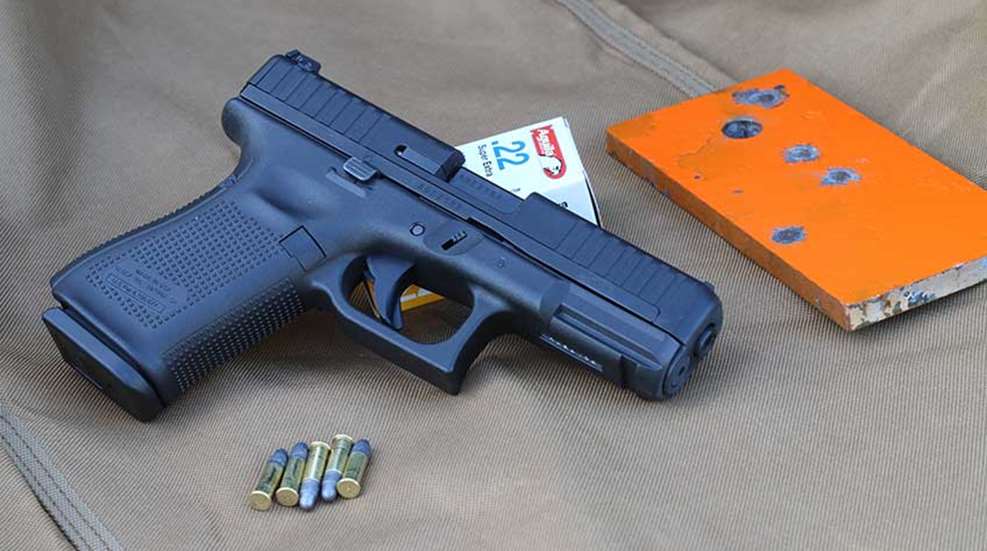
A little over a month ago, Glock released its G44, a G19-size, 10-round, .22 Long Rifle handgun. Interest was high, as is the case with most of Glock’s new products. The pistols began hitting dealer’s shelves in early January 2020, and I was able to shoot one to provide some first impressions. A detailed technical review will follow from the staff in due time, but this may answer some initial questions.
The pistol, at first glance, is easily mistaken for its Glock G19 counterpart. A closer look reveals the unique slide and pencil barrel with the tiny hole at the muzzle. The G44 frame is indistinguishable from current Gen 5 G19s, and it fit perfectly in each of the standard Glock-style holsters I tried.
The trigger on the Glock G44 feels identical to the Gen 5 pistols I’ve examined. In sampling three G44s at the local store, each had minor variance typical of the design but were good Glock triggers with the usual weighted take-up and a predictable ‘wall’ with a somewhat crisp release. There was a hint of roll and movement through the break. My example’s pull was 6 lbs. straight through and approximately 4 lbs. at the wall.
Many rimfire conversions use aluminum or some type of alloy to lighten the slides and allow the pistol to function as a blowback. Glock went a different route, using polymer for most of the slide with steel inserts. It’s an interesting approach that makes for a lightweight pistol. The weight with a full 10 round magazine is only 16 oz. That’s in Smith & Wesson Airweight J-Frame territory. A Ruger 22/45 Lite is a respected trail gun and is 25 oz. by comparison. The Glock G19, for which the 44 is a surrogate, runs 30 oz. with a full magazine.
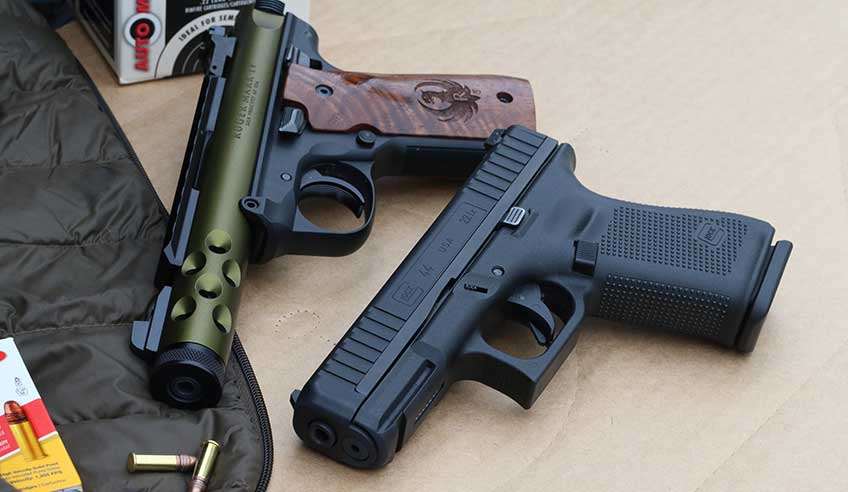
This light weight makes the G44 accessible to many first-time shooters. It is not intimidating for even a relatively young shooter to hold on target. On the other hand, the light weight gives very little mass to counter the movement through the striker-fired trigger, forcing the shooter to be even more mindful of pulling through the resistance than with its centerfire counterparts.
I did not do the full American Rifleman accuracy protocol of five separate groups of five shots per load, but I did get a couple of groups just to get a sense of potential accuracy and compatibility with on-hand ammo. It stacked hits consistently into attractive 1.25” to 1.5” groups with a variety of loads. The initial accuracy is well beyond expectations and was a welcome surprise.
Many shooters are often surprised by just how little velocity difference there is between standard and high-velocity rounds in a short-barreled .22 handgun; both are typically subsonic and separated by very little compared to the rifle-length velocity gap of ~200 f.p.s. This is one reason I tend to choose standard velocity whenever a semi-automatic .22 will run it. The round is going about the same speed for all practical purposes with less noise, often running more cleanly and accurately, to boot.
The rimfire Glock G44 is going to appeal to a number of audiences: plinkers, first-time buyers who recognize the ubiquitous handgun profile along with the brand name, outdoorsmen and shooters looking for a rimfire understudy to their defensive pistol.
I started shooting the G44 thinking it was more likely to be a training tool than a legitimate small-game pistol. However, the accuracy it was showing made me step back and reconsider. I was easily knocking shotgun shells off of a rail, shot for shot, at 15 yds. and was able to put 4 out of 5 rounds on my 3” wide by 6” tall steel plate at 35 and 40 yds., with the fifth shots off the plate called fliers that will probably settle down as I get more familiar with the gun. I can’t think of many trail-gun type scenarios or instances where I couldn’t make the shot with this Glock. I hadn’t necessarily expected this, and it was a welcome surprise.
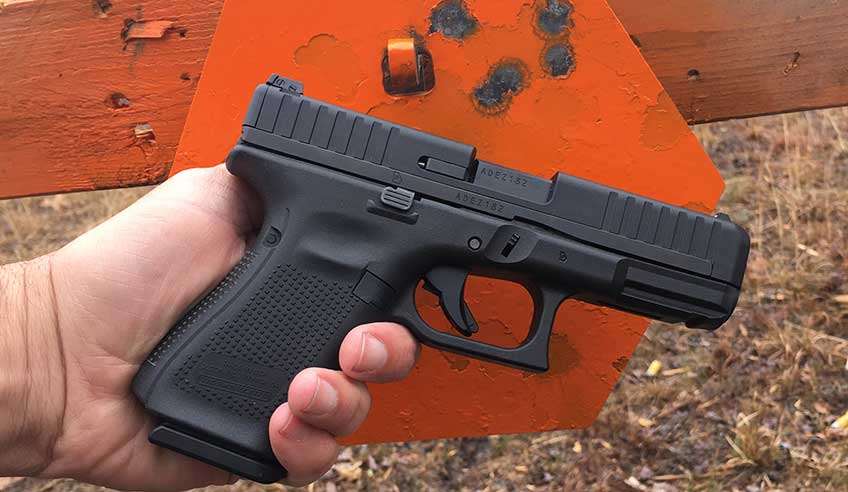
As a young man, a Ruger Single-Six revolver in .22 Long Rifle revolver was my constant companion in the woods. At some point, after the novelty of being armed diminished and following many long days with the steel revolver on my belt, I wished for a lighter handgun that I could shoot as well as the Ruger, but the market had little to offer on my budget. Now there are a variety of good options that are light enough to carry easily and plenty accurate. The Glock G44 is going to be a particularly attractive option for many.
Many shooters will be interested in the G44 to build their skills with a rimfire surrogate for their duty or carry gun. There are mixed feelings on this among serious students and trainers, but I am firmly in the camp that rimfire used thoughtfully can go a long way in skill development. I tried the G44 against a variety of drills, some that slanted toward accuracy and others speed or movement at more urgent distances.
I found the G44 to have a unique recoil impulse; it’s certainly light overall but with more movement in the sights and slight bounce in the slide’s reciprocation than with hammer-fired .22s such as the Beretta 92 and 1911 rimfire conversions. Although the recoil is mild-to-gentle by 9 mm Luger comparison, my shot-to-shot times (splits) on 10 yd. plate racks and six-shot Bill Drills on steel were about the same as my usual 9 mm Luger splits. These might come down with more familiarity or a different ammo choice, but I suspect many shooters will shoot better on drills due to the decreased muzzle rise but not necessarily faster.
However, even with the decidedly marginal OEM Glock sights, the G44 was very useful in focusing on trigger manipulation with the Glock Safe Action system. The precision of the little pistol allowed me to outshoot my normal stock Glock scores on 25 yd. bullseyes. Once the sights were adjusted, my groups piled into tight, little knots in the 10 ring.
The Glock piled up center hits in the head of Wilson Combat’s new scoreable steel silhouette at 25 yds. With the high contrast of the steel head box, I was able to see the trigger break clearly in the slight movement of the front sight and precisely call the shot. This is maybe the greatest training strength of the Glock G44; a stepping-stone linkage from deliberate dry-fire to easily seeing the front sight all the way through the striker release and calling the shot with the mild report and rise of the rimfire. Many shooters struggle to break a Glock trigger cleanly at distance with a number of factors in play, but the result is a challenge for most in calling the shot amid the blast and recoil. The G44 should help here.
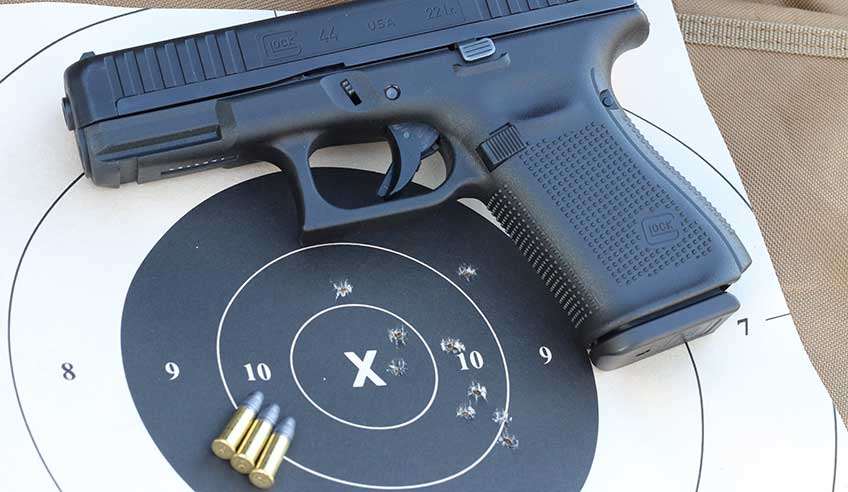
50-yd. plate racks were possible with the rimfire, something that is not particularly easy for me with a stock Glock 9mm. As long as the lighting was good, I was going five for five on the 8” MGM Plate Rack in a Bucket steel plates. On one 5-shot string, the ‘tink!’ ringing back from the steel had a virtually identical tone, and the movement of the steel plate behind the front sight was similarly cloned. That is not normal with a .22-cal. handgun at 50 yds. so I was pleased to find one of those ‘bragging-rights’ groups with lead splattered into a challenge coin-size cluster.
I finished up my first day with the G44 with a couple of my staple drills. The lightweight trainer aced the 5-Yard Roundup on the first go with time to spare in each of the 2.5 second strings. Much like the 50yd. plates I was able to really feel the trigger cleanly through the multiple shot strings, where the time pressure and recoil can cause many shooters to crash through the break with a service pistol.
I ended with runs of the 10 Second Showdown. My first had a hiccup or two and ended at an 89 with the second a solid ‘A’ well under 10 seconds at 98. My strong first impression is that the G44 will be distinctly useful as a trainer for Glock shooters.
Reliability. My Glock 44 had about six stovepipe stoppages, where the ejected brass is pinched by the breech face as the action attempts to chamber the succeeding round. Four of these were with Aguila Standard Velocity and two with Winchester bulk pack ‘333’ HV 36 grain hollow-points. I have had issues with the 333 load in multiple semi-automatic guns, so that wasn’t a huge surprise. The Aguila is not usually a finicky load so I tried some from the same carton in a couple of other semi-autos and also had some similar issues, leading me to believe that this particular lot may be slightly underpowered. It is pretty common with rimfire semi-autos to have some ammo that is less compatible and others that a gun prefers. The overall feel of the cycling was consistent across the six loads, and I suspect that the G44 will prove to be reliable with plenty of common, inexpensive loads. There were no failures to fire in the 400 or so rounds fired.
The only other issue I encountered were four instances of the first round hanging up on the feed ramp as the slide is released. I believe that this can be traced to the positioning of the topmost round. The shooter may need to jiggle the top round a bit after the filling the magazine to ensure a good angle and presentation upon reloading. It would be better if that wasn’t required, but my hard-used Smith & Wesson M&P15-22 rimfire carbine magazines require the same thing.
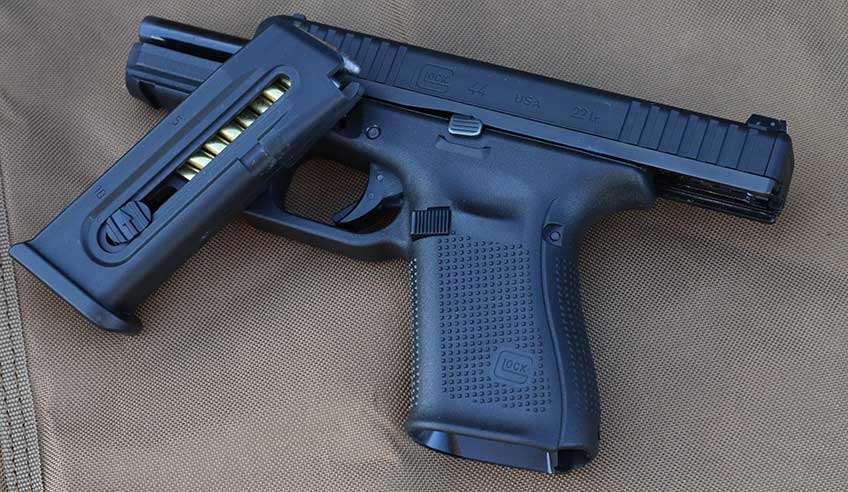
The magazines are pretty simple to fill, with prominent tabs on either side to depress the follower as the cartridges slide into the feeding slot. The Beretta 92 conversion magazines are still, in my mind, the high-water mark, with a quality, 15-round steel magazine in a polymer ‘wrap’ to bring it to 9 mm Luger size. I wish that Glock went this route to give more capacity and a more consistent top-round positioning, but the magazines are fine as is and feel similar enough to centerfire G19 mags to have some training benefit.
Overall, the Glock 44 has potential to please each of the markets that will have interest in it. In my shooting so far, the G44 was significantly more accurate than I expected while not quite as reliable as I had hoped. The little pistol will be extremely useful, as well as fun to shoot, and I expect Glock will sell trainloads of them.




































